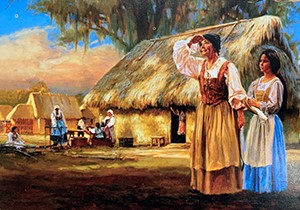Juana Caterina de Florencia
Mission San Luis

Juana Caterina de Florencia was a powerful presence at Mission San Luis. Born in St. Augustine in November 1662, she was the oldest child in a large family. Juana Caterina’s forbearers arrived in La Florida during the 16th century. The family had attained some prominence during the 1600s, with Juana’s grandfather becoming the first lieutenant-governor of Apalachee province (Florida panhandle) in the 1640s.
Juana married Captain Jacinto Roque Peres, who also became Apalachee province deputy-governor. A year-and-a-half after their first child was born, Jacinto was granted permission to settle in Apalachee Province. The rest of the couple’s nine children were probably born in the province. Part of Juana’s role at the Mission was to reinforce Spanish culture and ideas in the family and in the community. The missionaries had a sense of pride in being Spanish and creating a “Spanish atmosphere” in these new “frontier” locations.
Accounts of Juana’s time at the Mission indicate that she was often quite authoritarian in her actions. She engaged Apalachee servants to do chores and provide services for her family such as obtaining food, grinding corn meal, and bringing pitchers of milk from the countryside. Juana’s highborn status and large family are both possible reasons why she demanded these services. It is also reported that she once slapped the Apalachee chief because he brought meat instead of fish to her on a Friday. The fact that she was able to do all of these deeds with few repercussions (except complaints by the chief) and that she assumed she would receive the demanded services, suggests she enjoyed a degree of authority and status. Both Juana and her husband had daily interaction with not only the Apalachee people but also the Spanish soldiers. According to Juana and sources close to the couple, she and her husband made efforts to provide for the soldiers and Apalachee orphans at Mission San Luis.
Stop by Mission San Luis to learn more about Juana and the lives of the Spanish women who lived there.

